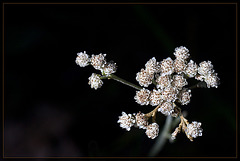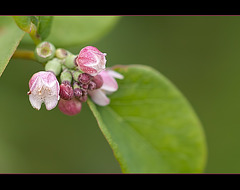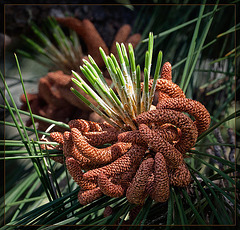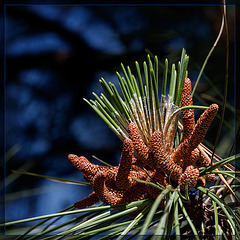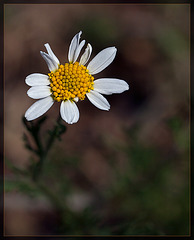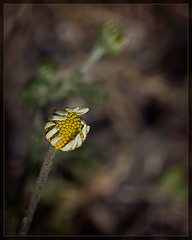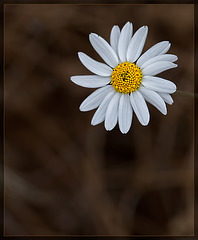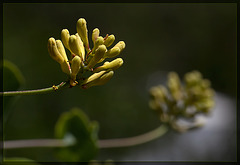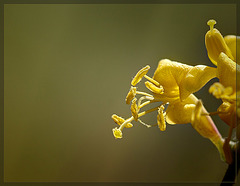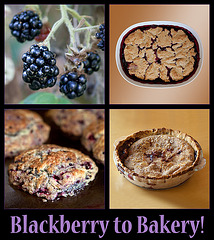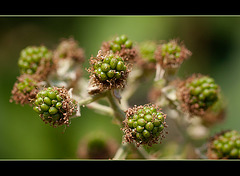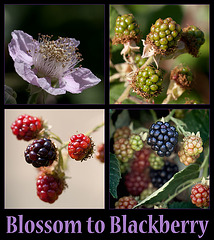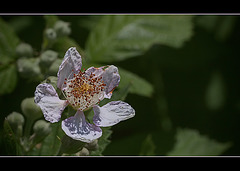
The Flowers of Spring & Summer!
I have decided to have a counting of each kind of flower that I find on our property this spring and summer! I saw the first flower in early February and it's the smallest flower too! Next I found a little white flower that looks ready for a mouse's wedding bouquet! Number three were the crocus flowers that popped out in one big clump of loveliness! Then I discovered the Henderson Shooting Star, b…
(read more)
Stringflower: The 133nd Flower of Spring & Summer!
| |
|
(I've made this one public so people can get a better look, thank you so much for your wonderful comments!!)
Stringflower: The 133nd Flower of Spring & Summer!
| |
|
Stringflower: The 133nd Flower of Spring & Summer!
| |
|
I was prowling around looking for this flower for weeks before it finally bloomed, and when it did, I went crazy taking pictures because I love it so much! Growing only a few inches tall, this gorgeous flower features blossoms about 1" in diameter, and as you can see from my images, the color ranges from pink-pearl white to blushing pink and the petals can vary in arrangement as well. (Apparently it can be white and purple as well in some places)
Stringflowers are native to western Oregon and northwestern California and grow in shady forests where it likes partial sun. You may see the similarity to carnations, as this flower is also in that family! The name "Stringflower" is given for one species which has white petals divided into four narrow, string-like lobes. (I found a very nice example of a white Stringflower on Flickr, thanks to Angelique Eeek )
If you would like more information about this flower, Wiki has a source here: Wiki: Stringflower (Silene hookeri)
Smallflowered Everlasting: The 134th Flower of Spr…
| |
|
|
Did you think I was done with my flower count???!!! Heavens no! There are still dozens of species I have yet to display, if you can believe it!! Honestly, I'm totally stunned that I found this many! I also think it's funny to be showing off flowers in September that I photographed in June, but as the weather begins to get cold, it will be nice to share these summer flowers with you all so we have something pretty to look forward to! :D
I found this little beauty all by itself under a canopy of Oak trees in early June. Also known as "Pussy Toes" because of the cat's toes appearance of the blossoms, this flower can be found all over the Pacific Northwest and grows to the height of 10-12". Smallflowered Everlasting is one of about 45 species that are found in the Northern Hemisphere. They are a favorite food of various butterfly and moth species, and are also used in floral arrangements! :) This flower is called "Everlasting" because it will last indefinitely when dried.)
If you would like to know more about these flowers, Wiki has a good page here: Everlasting (Antennaria)
Snowberry: the 135th Flower of Spring & Summer! (4…
| |
|
A few of these bushes grow down by our front gate, and are favorites of bees and other insects. The blossoms are only about 1/4" in diameter, but as you can see, they're beautiful little pink bells when seen up close! :) After flowering, they make pretty white berries which are gobbled up by the wildlife but are poisonous to humans. (A picture of a snowberry is below!)
Snowberry plants are part of a group of about 15 species that are found in Northern and Central America and are a common shrub. Their family name is "Symphoricarpos", which means "bear together fruit", referring to the tightly-packed clusters of berries. Some species of this plant are also used for landcaping.
If you would like to know more about this plant, Wiki has a good source here: Wiki: Snowberry (Symphoricarpos)
Male Pine Cone: The 136th Flower of Spring & Summe…
| |
|
|
Male Pine Cone: The 136th Flower of Spring & Summe…
| |
|
|
WHAT?! Ok, ok, I'm cheating and I don't care! I think male pine cones look as pretty as flowers and since they release pollen, I'm including this as one of the Flowers of Spring & Summer! :) So there! :D
The first thing to know is that pine cones don't have flowers! Instead, these trees have male cones that release pollen and female cones that receive the pollen and produce seeds. Male cones look very different and grow on the lower branches, whereas female cones grow on the upper branches. They are the cones we all recognize. They receive the pollen released by the male cones and produce seeds. Isn't that fascinating?! I always wondered what these things were!
If you would like to know more about pine cones, Wiki has a very nice page here: Wiki: Conifer Cone
137thflowerdaisy
| |
|
137htflowerdaisybud
| |
|
137htflowerdaisy2
| |
|
Common Daisy: The 137th Flower of Spring & Summer!…
| |
|
What a surprise! I thought the little daisies that we all see in our lawns are Common Daisies! They aren't! "Lawn" daisies can be several different species but are usually "English Daisies".
This flower is much larger than a lawn daisy. It has blossoms that are about 1" in diameter and grows 5-12 off the ground, and can form large plants covered with pretty white blossoms. They are very drought-resistant and somehow manage to grow without any water at all! Another difference you'll notice is that the petals are fewer in number and each is wider than that of a lawn daisy.
Also known as an Oxeye Daisy, it's native to Europe and Asia, but has become naturalized all over the United States, Australia and New Zealand, growing in meadows, along roadsides and disturbed areas. It's considered to be a weed to some. Unopened flowers are sometimes marinated and eaten like capers in salads! I even found a Daisy Capers recipe ! These flowers can cause contact dermatitis to those sensitive to allergies. Common Daisies are often found in wildflower seed mixes and are a popular cultivated flower.
If you would like to know more about this daisy, Wiki has a nice page here: Wiki: Common Daisy (Leucanthemum vulgare)
138htflowerChaparralHoneysuckle3
| |
|
138htflowerChaparralHoneysuckle2
| |
|
Chaparral Honeysuckle: The 138th Flower of Spring…
| |
|
|
|
2 pictures above in notes! :)
This beautiful flower grows on tough vines around the base of some of the Oak trees on our property. I really didn't think I would be able to identify them but I realized that these pretty little blossoms look like honeysuckle...and what do you know! This is a wild species of honeysuckle which is more like a weed than the larger, more ornate species you'd grow in your garden. The blossoms are tiny, but as you can see, they are like little, peach-colored jewels when viewed through a macro lens!
Chaparral Honeysuckle is just one of about 180 species of honeysuckle species, which are native to the northern hemisphere. This species is found in the Pacific Northwest and is very drought-tolerant, growing in hot, dry habitats. Like all honeysuckle species, this one also attracts humingbirds! :)
If you would like to know more about honeysuckle species, Wiki has a nice page here: Wiki: Honeysuckle
Himalayan Blackberry: Berry to Bakery!
| |
|
YUMMY YUMMY YUMMY!!!! You may wonder why blackberries are expensive...go blackberry picking and you'll find out why. It's DANGEROUS!!! Blackberry bushes are covered with thorns and there is no way to avoid getting stabbed and scratched. However, the resulting berries are well worth the blood loss!!
Steve and I haven't made jam or jelly yet, but every season we make several cobblers, pies, and dozens of delicious scones! At this moment, we have cobbler and scones in the refrigerator! Blackberry season is the BEST! :D
Himalayan Blackberry: Green Berries
| |
|
I really loved how this picture turned out, showing how pretty blackberries appear in the first stage after the blossoms fall and the berry begins to form!
Himalayan Blackberry: Blossom to Blackberry!
| |
|
A collage is the perfect way to show the progression of a blossom to ripe berry! I had such a fun time taking pictures of the different stages! :)
Himalayan Blackberry: The 139th Flower of Spring &…
| |
|
Jump to top
RSS feed- Latest items - Subscribe to the latest items added to this album
- ipernity © 2007-2024
- Help & Contact
|
Club news
|
About ipernity
|
History |
ipernity Club & Prices |
Guide of good conduct
Donate | Group guidelines | Privacy policy | Terms of use | Statutes | In memoria -
Facebook
Twitter




